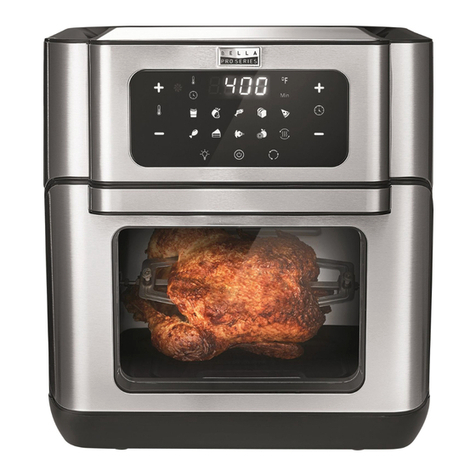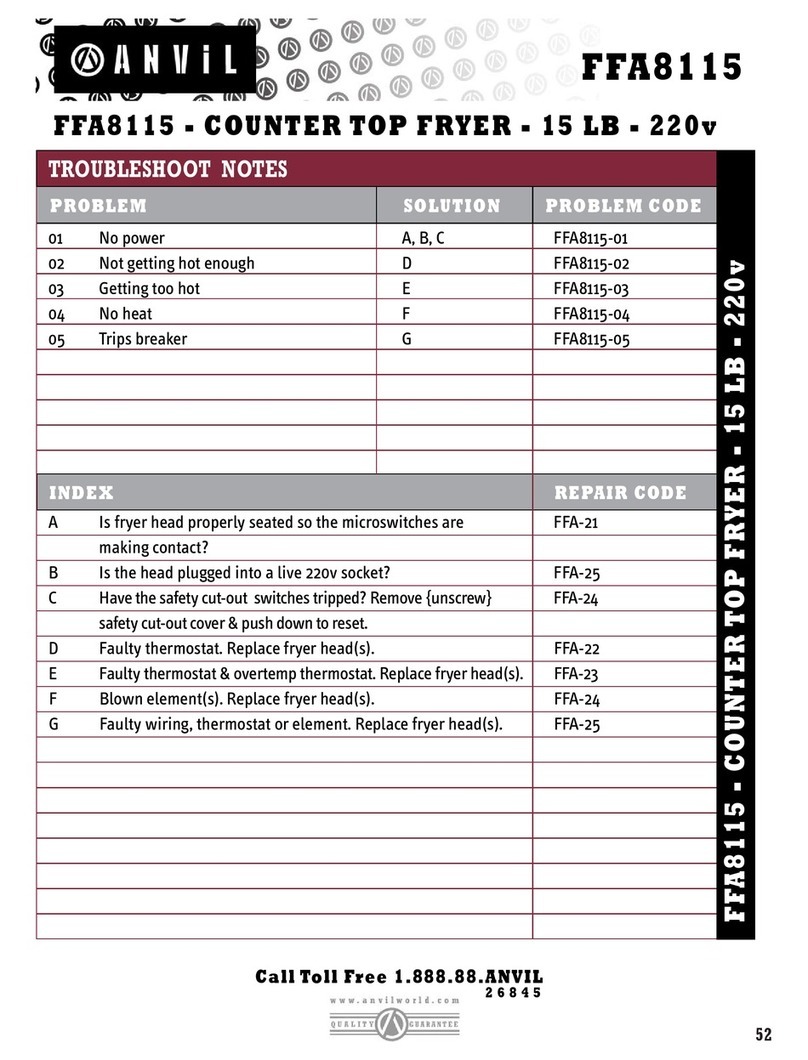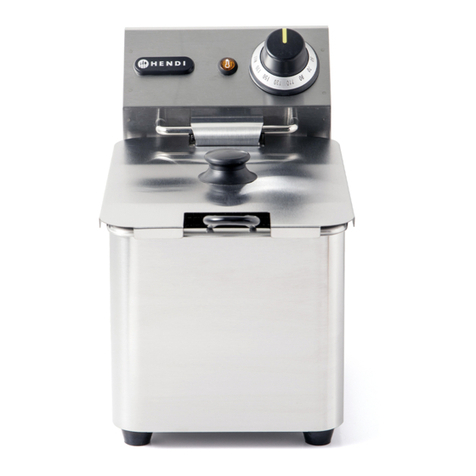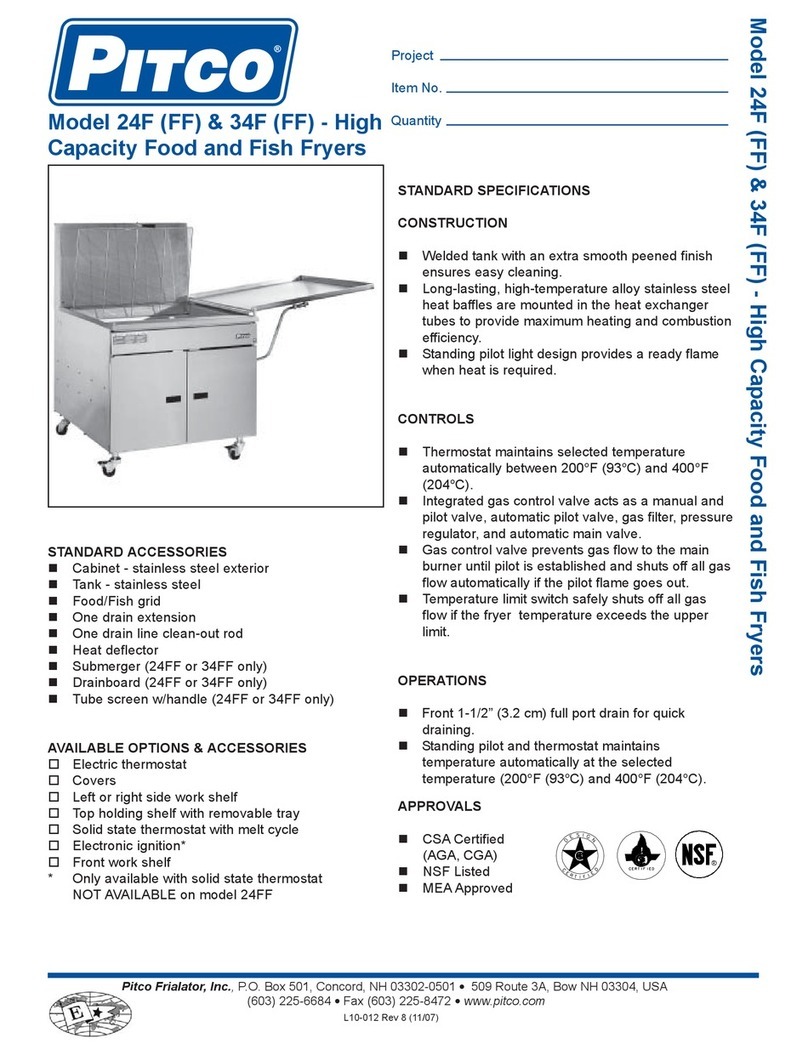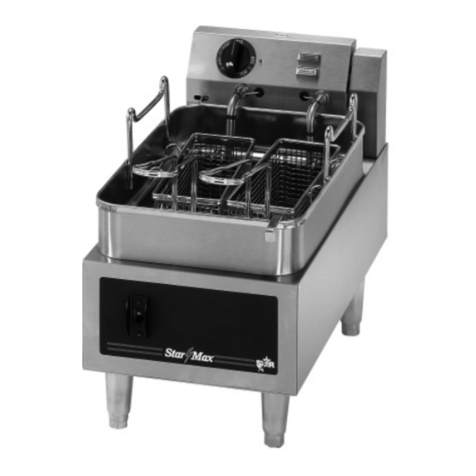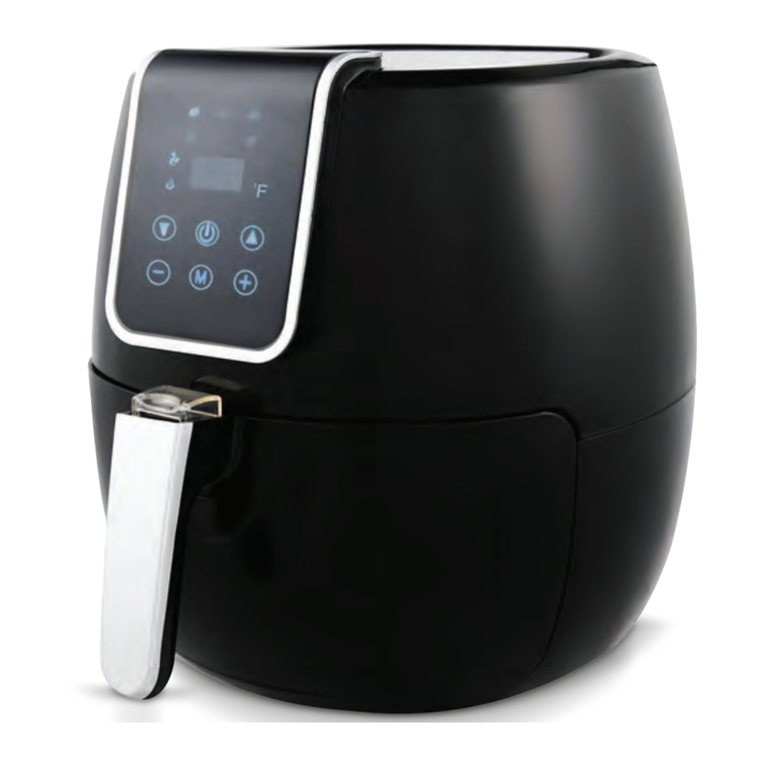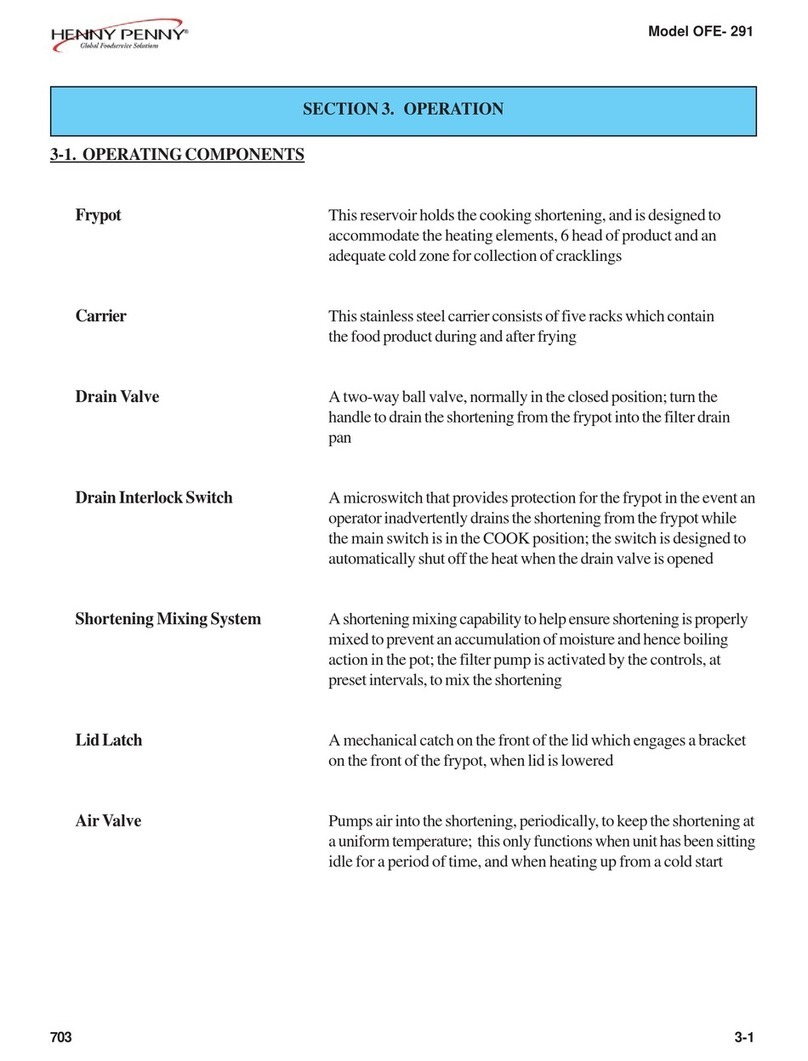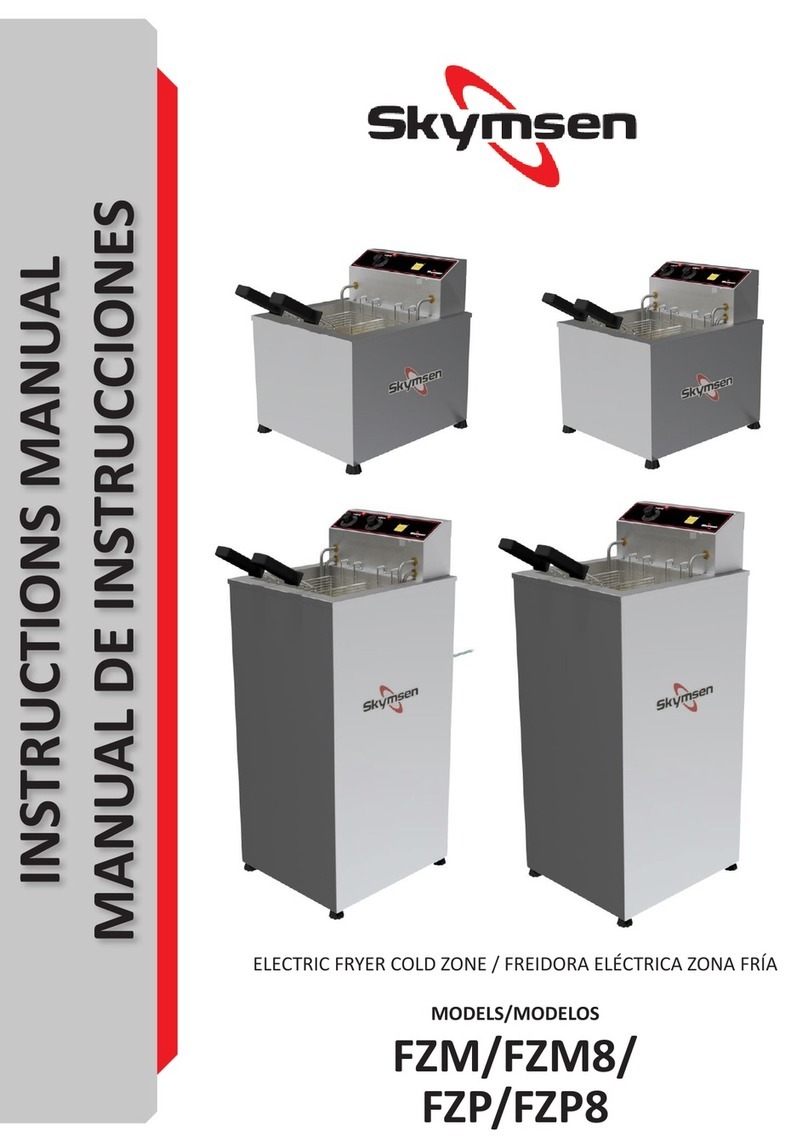ECRON DF-03F User manual

ES
EN
DF-03F
FREIDORA
ELECTRIC DEEP FRYER
Manual de usuario /
User manual

2 3
Lea detenidamente todas las
instrucciones de seguridad incluidas
en este manual antes de utilizar el
aparato. En él encontrará consejos
importantes relativos al uso,
mantenimiento y limpieza del aparato.
Guarde este manual en un lugar
seguro y consérvelo para posteriores
consultas.
Before using the appliance, please
read all the safety instructions
included in this manual carefully. In
it you will find important advice on
how to use, maintain and clean the
appliance.
Put this manual in a safe place and
keep it so that you can refer to it
another time.

4 5
IMPORTANTES MEDIDAS DE SEGURIDAD cualificación similar, sustituirlo para evitar cualquierriesgo.
7. Utilice siempre la freidora con la tapa colocada.
8. La utilización de accesorios no recomendados o
no vendidos por el fabricante pueden provocar un
incendio, una descarga eléctrica o lesiones físicas.
9. Desenchufe el aparato de la toma de corriente
cuando no se utilice, antes de limpiarlo o de montar
o desmontar las piezas. Para desconectar el aparato,
apague cualquier interruptor o control y desenchúfelo de
la toma de corriente tirando de la clavija (nunca del cable).
10.Este aparato no debe ser usado por niños desde
0 hasta 8 años. Este aparato puede ser usado por
niños de 8 años de edad y mayores de 8 años si
están continuamente supervisados. Este aparato
puede ser usado por personas con capacidades
físicas, sensoriales o mentales reducidas o con falta
de experiencia y conocimiento si están supervisados
o han recibido instrucción concerniente al uso del
aparato de una forma segura y entienden los riegos
que éste implica. Mantener el aparato y su cable fuera
del alcance de los niños de edad inferior a 8 años. La
limpieza y el mantenimiento no deben ser realizados
por niños.
11. Guardar este aparato fuera del alcance de los niños
ES
Antes de utilizar este aparato eléctrico, se deben cumplir
unas medidas de seguridad básicas, entre las que se
incluyen las siguientes:
1. Lea con atención las instrucciones y guárdelas con
el aparato. Asegúrese de que ha entendido bien las
medidas de seguridad aquí mencionadas.
2. Asegúrese que la tensión de la red se corresponde con
la que aparece en las especificaciones del aparato.
3. Conecte la freidora a un enchufe con toma de puesta
a tierra.
4. Utilice siempre el aparato sobre una superficie
lisa, seca y estable. No deje que el cable toque una
superficie caliente ni cuelgue del borde de una mesa o
superficie de trabajo en la que se encuentra la freidora.
5. No ponga en funcionamiento ningún aparato que
tenga dañados el cable o la clavija, después de un
mal funcionamiento del aparato, o si se ha dañado
de algún modo. Lleve el aparato al Servicio Técnico
autorizado para su examen, reparación o puesta a
punto. No intente repararlo usted mismo.
6. Si el cable de alimentación está dañado, corresponde
al fabricante, a su representante o a una persona de

6 7
12.Durante la fritura se libera vapor caliente. Mantenga
una distancia de seguridad de este vapor caliente.
13.Nunca coloque este aparato donde pueda entrar en
contacto con un aparato que emita calor.
14.Este aparato no está destinado a ser utilizado
mediante un sistema de temporizador externo o
mando independiente.
15.No utilice el aparato para un uso distinto del que se le
ha destinado.
16.No utilice la freidora al aire libre.
17. Este aparato está previsto para su utilización como
aparato de uso doméstico y análogo como:
• pequeñas áreas de cocina en tiendas, oficinas y otros
entornos laborales;
• casas de campo
• por clientes en hoteles, moteles y otros entornos de
tipo residencial
• entornos del tipo albergues.
18.Los aparatos de cocinado deben estar colocados en
una situación estable con las asas (si existen) colocadas
para evitar el derramamiento de líquidos calientes.
19.Todos los materiales de este aparato que puedan
entrar en contacto con alimentos cumplen la
Normativa vigente.
20.La garantía se invalidará en caso de reparaciones
no autorizadas.
ES
21.El símbolo "SUPERFICIE CALIENTE" advierte al
usuario que las paredes de las superficies pueden
calentarse durante el uso, para que tome
precauciones según sea necesario.

8 9
SEGURIDAD
Dispositivo de seguridad de
sobrecalentamiento
En caso de sobrecalentamiento,
el dispositivo de seguridad
desconectará la freidora. Esto
puede ocurrir si la freidora no
se llena con suficiente aceite
o si la grasa sólida se funde
en la freidora. En el caso de
que la grasa sólida se funda
en la freidora, el elemento de
calefacción es incapaz de irradiar
el calor producido con la suficiente
rapidez. Si el dispositivo de
seguridad apaga la freidora,
proceda de la siguiente manera:
- Deje enfriar el aceite o la grasa
- Presione con cuidado el
interruptor “reset” en la parte
trasera del elemento de control
con un destornillador pequeño.
Interruptor de seguridad
El interruptor de seguridad en el
elemento de control asegura que
el elemento calefactor sólo puede
funcionar cuando el elemento de
control encaja con un clic.
Zona fría
Durante el proceso de fritura,
las partículas de alimentos
se acumulan en el fondo del
recipiente. Como el elemento
calefactor está dispuesto debajo
del recipiente y calienta el aceite
/ grasa desde la zona superior de
la freidora, el aceite / grasa entre
la base y el elemento calefactor
permanece relativamente frío
(zona fría). Esto impide que las
partículas de alimentos en esta
zona se quemen y ofrece la ventaja
de poder utilizar el aceite o la
grasa más de una vez.
Grasa sólida
Recomendamos el uso de aceite
o grasa líquida para freír en esta
freidora. También se puede usar
grasa sólida para freír. Con el fin
de evitar salpicaduras y que la
freidora esté demasiado caliente,
deben tomarse las siguientes
precauciones:
• Cuando use grasa, deje
que los bloques de grasa se
derritan lentamente a fuego
moderado en una sartén.
Vierta cuidadosamente la
grasa derretida en la freidora.
Enchufe la clavija en la red
y encienda la freidora (ver
sección “como utilizar la
freidora”).
• Después del uso, almacene
la freidora con la grasa
resolidificada a temperatura
ambiente. Si la grasa está
demasiado fría, puede salpicar
cuando se recalienta.
Para evitar que esto suceda,
pinche la grasa sólida con un
tenedor varias veces. Tenga
cuidado de no dañar el elemento
calefactor.
ES

10 11
INSTRUCCIONES DE USO
Antes del primer uso
• Antes de utilizar la freidora
por primera vez se deben
limpiar y secar completamente
las piezas individuales (ver
apartado “Limpieza”)
• Coloque la freidora en una
posición horizontal en una
superficie nivelada y estable.
• Si la freidora está colocada
bajo una campana extractora
en la cocina, debe asegurarse
de que la cocina esté apagada.
• Extraiga el cable de alimentación
completamente fuera del
almacenamiento del cable.
• Retire la tapa.
• Retire la cesta.
• Encaje la empuñadura con
cuidado a la cesta.
• Llene la freidora seca y limpia
con aceite hasta la marca
superioren el recipiente (3 litros
de aceite o 2,5 Kg de grasa).
• Nunca mezcle diferentes tipos
de grasa o aceite
• Enchufe la clavija de red.
• El cable de alimentación no
debe entrar en contacto con
las partes calientes de la
freidora.
Como utilizar la Freidora
• Encienda la freidora pulsando
el interruptor “power” de
encendido / apagado. El
indicador luminoso verde se
encenderá.
• Ajuste el termostato a la
temperatura deseada. La
temperatura de fritura correcta
se encuentra en el envase de
alimentos o en la tabla al final
del manual.
• La luz de control de la
temperatura se ilumina en
rojo. La grasa / aceite alcanza
la temperatura requerida en 10
- 15 minutos.
• Mientras la freidora calienta
hasta la temperatura
seleccionada, la luz de control
se encenderá y apagará varias
veces. La luz permanece
encendida mientras los
elementos calefactores estén
calentando. Al alcanzar la
temperatura seleccionada, la
luz se apaga.
• Introduzca la cesta vacía
cuando la luz de control no se
encienda durante algún tiempo.
• Cuando se utiliza aceite o
grasa líquida, la cesta puede
permanecer en la freidora
calentando. La cesta también
se puede dejar en la freidora si
la grasa alrededor de la cesta
se ha solidificado.
• Retire la cesta de la freidora
y llene con el producto que
desee freír.
• No exceda la cantidad de
llenado máxima especificada
en estas instrucciones
(ver tabla).
• Coloque cuidadosamente la
cesta en la freidora y coloque
la tapa. En la tapa se
proporciona una ventana de
observación para observar el
proceso de fritura.
• Durante el proceso de fritura,
retire ocasionalmente la cesta
del aceite de grasa y agite
cuidadosamente el contenido.
Después de freír
• Después de freír, retire la tapa
y coloque la cesta en la parte
superior para permitir que el
aceite gotee.
• Levante con cuidado la cesta
del recipiente. Si es necesario,
sacuda el exceso de aceite o
grasa sobre la freidora.
• Coloque el producto frito en
un recipiente o sobre papel de
cocina absorbente.
• Apague la freidora con
el interruptor “power” de
encendido / apagado y ajuste
el termostato en el nivel más
bajo (gire el termostato en
sentido contrario a las agujas
del reloj.
• Si la freidora no se utiliza
regularmente, se recomienda
almacenar el aceite o la grasa
líquida en un recipiente en
un lugar fresco después de
haberlo enfriado y filtrado a
través de un tamiz fino.
• Para vaciar la freidora, retire la
ES

12 13
tapa, la cesta y el elemento de
calefacción. Retire el recipiente
de la freidora y vierta el aceite
o grasa (consulte la sección
“Limpieza”).
• Si la freidora contiene grasa
sólida, permita que la grasa
se solidifique en la freidora y
guarde la grasa en la freidora
(vea la sección “Grasa sólida”).
LIMPIEZA
• Desconecte la clavija de la red.
• Espere hasta que el aceite
o grasa esté frío antes
de limpiarlo. No se debe
permitir que la grasa sólida se
solidifique completamente.
• Retire la tapa, la cesta y el
elemento de calefacción.
• Guarde el elemento de
calefacción en un lugar
seguro yseco.
• El elemento de calefacción
nunca debe sumergirse en
agua o limpiarlo con agua
corriente. Estas partes se
deben limpiar con un paño
húmedo si es necesario.
• Retire la cesta y vacíe la grasa
/ aceite.
• Limpie la tapa, el recipiente,
la cesta y el cuerpo con el
detergente en agua caliente.
Enjuague con agua limpia y
seque bien. No utilice agentes
de limpieza cáusticos o
abrasivos.
• Vuelva a montar la freidora
introduciendo el recipiente,
el elemento de calefacción
finalmente la cesta.
• Encaje la empuñadura
doblándola en la cesta.
• Enrolleel cable de alimentación
e insértelo junto con la clavija
en el almacén del cable.
• Levante la freidora con
la ayuda de las asas de
transporte laterales.
• Guarde la freidora con la tapa
cerrada. Esto mantendrá el
interior de la freidora limpia y
libre de polvo.
CONSEJOS
PATATAS FRITAS HECHAS EN
EL HOGAR
COMO HACER DELICIOSAS
PATATAS FRITAS:
• Las patatas destinadas a la
freidora no deben mostrar signos
de brotes.
• Corte las patatas en la forma que
desee (tiras, dados o rebanadas).
• Coloque las patatas en agua
durante aproximadamente una
hora antes de freírlas. Parte de los
azúcares, una de las sustancias
principales responsables de
la formación de acrilamida, se
elimina.
• Deje que las patatas se sequen
completamente.
• Freír siempre dos veces las
patatas fritas caseras. Primero
durante 4-6 minutos a 160 ° C y
después 2-4 minutos a un máximo
de 175 ° C.
• Cuando se fría por segunda vez,
levante la canasta de la freidora
varias veces y agítela para soltar
las patatas fritas. De esta manera,
todas tendrán un color bonito,
ES

14 15
incluso dorado.
• Las patatas fritas congelados son
precocinadas y por lo tanto solo
necesitan ser fritas una vez. Siga
las instrucciones del fabricante.
• Los productos congelados (-16 a
-18 ° C) enfrían el aceite o la grasa
considerablemente y por lo tanto
no se fríen lo suficientemente
rápido y pueden absorber aceite o
grasa en exceso.
Esto se puede evitar de la siguiente
manera:
• No freír grandes cantidades al
mismo tiempo (ver tabla)
• Caliente el aceite al menos 15
minutos antes de añadir el producto.
• Ajuste el termostato a la
temperatura especificada en estas
instrucciones o en el envase del
producto.
• Permita que el producto
congelado se descongele a
temperatura ambiente. Elimine
la mayor cantidad de hielo y
agua como sea posible antes
de colocar el producto lenta y
cuidadosamente en la freidora.
Los productos congelados tienen
tendencia a causar que el aceite o
grasa calientes salpique de manera
violenta.
CÓMO ELIMINAR LOS SABORES
NO DESEADOS
Algunos alimentos, en particular
los pescados, liberan líquidos
mientras se están friendo. Estos
líquidos se acumulan en el
aceite o grasa y afectan al olor y
sabor de otros productos fritos
posteriormente en el mismo aceite
o grasa. Este sabor del aceite o
grasa se puede neutralizar de la
siguiente manera:
Caliente el aceite o la grasa a 160
° C y agregue dos finas rebanadas
de pan o un poco de perejil a la
freidora. Espere hasta que el aceite
o la grasa deje de burbujear y
retire el pan o el perejil. El sabor
de la grasa o aceite ahora es
neutral otra vez.
Los nutricionistas recomiendan el
uso de aceites y grasas vegetales
que contienen ácidos grasos
insaturados (por ejemplo, aceite de
oliva). Estos aceites y grasas, sin
embargo, pierden sus propiedades
positivas más rápidamente que
otros tipos y por lo tanto deben ser
cambiados con más frecuencia.
La siguiente información es para
orientación:
• Si la freidora se utiliza
habitualmente para patatas
fritas o el aceite o la grasa se
tamiza después de cada uso se
puede utilizar 10 o 12 veces.
• No use el aceite más de seis
meses.
• Por lo general, el aceite o
la grasa no se puede usar
durante mucho tiempo si se
usa para freír alimentos con
alto contenido en proteínas
tales como carne o pescado.
• No mezcle aceite fresco con
aceite usado.
• Cambie el aceite o la grasa si
comienza a formar espuma
cuando se calienta, si
desarrolla un olor extraño
o se oscurece y / o tiene
consistencia de jarabe.
ELIMINACIÓN DE RESIDUOS
El aceite o grasa usada se puede
eliminar en su botella de plástico
original sellándola bien. Si
utiliza grasa sólida, deje que se
solidifique en la freidora y retírela a
continuación.
TABLA
Esta tabla muestra las cantidades
de productos alimenticios y la
temperatura requerida y los
tiempos de fritura.
Si las instrucciones del fabricante
de producto difieren de los valores
mostrados en esta tabla, se deben
seguir las instrucciones del envase.
ES

16 17
TemperaturaT ipo de producto
Cantidad mx ima
por ciclo
Fresco o
Descongelado
(Minutos) Tiempo de fritura
Fresco Congelado Congelado
160º Patatas fritas caseras (primer ciclo)
Pescado fresco
700 g
500 g
4-5
5-7
--
--
--
--
170º Alitas de pollo
Croquetas de queso
Pequeños rebozados de patata
Verduras fritas (champiñones,
coliflor)
Patatas fritas caseras (segundo
ciclo-max 175º)
Patatas fritas congeladas–max 175º
4-6
5
--
10-12
700 g
--
4-5
4
4
--
--
550 g
12-5
4-5
--
2-3
3-4
--
15-20
6-7
3-4
--
--
5-6
180º 3
10-12
10-12
8-10
8-10
15-20
10-12
10-12
10-12
5
2
10
10
--
8
15
10
10
10
--
6-7
3-4
3-4
3-4
3-4
3-4
3-4
3-4
3-4
3-4
10-12
4-5
4-5
4-5
4-5
4-5
4-5
4-5
4-5
--
Rollitos de primavera
Nuggets de pollo
Mini aperitivos
Albóndigas (pequeñas)
Palitos de pescado
Mejillones
Anillas de Calamar (Rabas)
Pescado rebozado
Langostinos
Aros de cebolla
190º 700 g
600 g
5
5
4-5
2-4
2
2
550 g
--
4
4
--
--
--
--
3-4
3-4
4-5
4-5
5-6
2-3
4-5
3-4
5-6
--
6-7
6-7
--
--
--
--
Patatas fritas tradicionales
Tiras de berenjena
Croquetas de patata
Croquetas de carne/pescado
Rosquillas
Queso camembert rebozado
Cordon bleu
Salchicha de Viena
MODELO
Potencia
Capacidad máxima
Alimentación
ESPECIFICACIO NES TÉCNICAS
DF-03F
2100 W
3 Litro
220-240V~ 50Hz
s
ES

18 19
GARANTÍAS
La vigente Ley de Consumidores y Usuarios, le confiere como cliente los siguientes derechos:
1.- EJERCICIO DE LOS DERECHOS.
El vendedor responderá de cualquier falta de conformidad que exista en el momento de la entrega del
bien. Cuando al consumidor le resulte imposible o le suponga una carga excesiva dirigirse frente al ven-
dedor por la falta de conformidad de los bienes con el contrato de compraventa podrá reclamar directa-
mente con el fin de obtener la sustitución o reparación del bien.
Su responsabilidad se prolongará por un plazo de dos años desde la entrega del bien. En los bienes de
segunda mano, el vendedor y el consumidor podrán pactar un plazo menor que no podrá ser inferior a
un año desde la entrega.
2.- DERECHO A LA REPARACIÓN YSUSTITUCIÓN DEL PRODUCTO NO CONFORME.
Si el producto adquirido no fuera conforme con el contrato, el cliente podrá optar entre exigir la repara-
ción o la sustitución del mismo, salvo que una de estas opciones resulte imposible o desproporcionada.
A estos efectos se considerará desproporcionada toda forma de saneamiento que imponga al vendedor
costes que, en comparación con la otra forma de saneamiento, no sean razonables, teniendo en cuenta
el valor que tendría el bien si no hubiera falta de conformidad, la relevancia de la falta de conformidad y
si la forma de saneamiento alternativa se pudiese realizar sin inconvenientes mayores para el Consumi-
dor. Esta reparación y sustitución:
1. Será gratuita para el consumidor.
2. Se llevará a cabo en un plazo razonable y sin mayores inconvenientes para el consumidor.
3. La reparación suspenderá el cómputo del plazo de dos años para manifestar la falta de conformi-
dad del bien hasta la entrega del bien reparado.
4. La sustitución suspenderá el cómputo del plazo de dos años para manifestar la falta de conformi-
dad del bien hasta la entrega del nuevo bien.
5. Si reparado o sustituido el bien, éste sigue sin ser conforme al contrato, el consumidor podrá
solicitar la resolución del contrato o la rebaja de precio.
6. El consumidor no podrá exigir la sustitución del bien en casos de bienes no fungibles ni tampoco
cuando se trate de bienes de segunda mano.
7. El vendedor podrá hacer efectiva esta garantía a través de sus propios medios o de los establecidos al
efecto por el fabricante o distribuidor, independiente de la existencia o no de una garantía comercial.
3.- DERECHO A LA REBAJA DEL PRECIO YRESOLUCIÓN DEL CONTRATO.
La rebaja del precio y la resolución del contrato procederán, a elección del consumidor, cuando éste no
pudiera exigir la reparación o la sustitución y en los casos en los que éstas no se hubieran llevado a cabo
en un plazo razonable o sin mayores inconvenientes para el consumidor. La rebaja de precio deberá ser
proporcional a la diferencia de valor existente entre el valor que el bien hubiera tenido en el momen-
to de la entrega, en el caso de haber sido entregado conforme con el contrato, y el valor que el bien
efectivamente entregado tenía en el momento de la entrega. No obstante, la resolución del contrato no
procederá cuando la falta de conformidad sea de escasa importancia.
ES

20 21
IMPORTANT SAFETY MEASURES
Before using this electrical appliance, some basic safety
measures must be adhered to, including the following:
1. Read the instructions carefully and keep them with the
appliance. Ensure that you have understood the safety
measures listed here.
2. Ensure that the network voltage corresponds to the
specifications listed on the appliance.
3. Plug the fryer into an earthed mains socket.
4. Always use the appliance on a smooth, dry and stable
surface. Do not let the cable come into contact with a
hot surface or hang over the edge of the table or work
surface on which the fryer is sitting.
5. Do not operate any appliance that has a damaged
cable or plug, an appliance that is not operating
correctly or one that is damaged in any way. Take the
appliance to an authorised technical support service
for examination, repair or servicing. Do not attempt to
repair it yourself.
6. If the power cable is damaged, contact the
manufacturer, its representative or someone similarly
authorised, and replace it to prevent any risk.
7. Always use the fryer with the cover closed.
8. Use of accessories that are not recommended or not
sold by the manufacturer could lead to a fire, electric
shock or physical injury.
9. Unplug the appliance from the mains supply when it
is not in use, before cleaning it or when assembling or
disassembling parts. To disconnect the appliance, switch
off any switches or controls and unplug it from the
mains supply, pulling it by the plug (never the cable).
10.This appliance should not be used by children under
8 years old. This appliance may be used by children
aged 8 and above, as long as they are under constant
supervision. This appliance can be used by persons
with reduced physical, sensory or mental abilities or
those with a lack of experience and knowledge, if they
have been given supervision or instruction concerning
use of the appliance in a safe way and as long as they
understand the hazards involved. Keep the appliance
and its cable out of the reach of children younger than
8 years old. Cleaning and upkeep must not be carried
out by children.
11. Keep this appliance out of the reach of children.
12.Hot steam is released during frying. Keep a safe
distance from this hot steam.
13.Never set this appliance where it could come into
EN

22 23
contact with a heat-emitting appliance.
14.This appliance is not intended to be used with an
external timer system or independent control.
15.Do not use the appliance for anything other than its
intended purpose.
16.Do not use the fryer outdoors.
17. This appliance is intended for household or similar
use, such as:
• small kitchen areas in shops, offices and other places
of work;
• country houses
• for customers in hotels, motels and other places of residence
• hostels
18.Cooking appliances must be set in a stable place with
the handles (if applicable) positioned so as to prevent
the spillage of hot liquids.
19.All of the materials in this appliance that could
come into contact with foodstuffs comply with the
regulations in force.
20.Unauthorised repairs will invalidate the warranty.
SAFETY
Overheating safety device
In the event of overheating, the
safety device will disconnect the
fryer. This can occur if the fryer
is not sufficiently filled with oil
or if hardened fat melts in the
fryer. If hardened fat melts in the
fryer, the heating element is not
able to radiate the heat produced
quickly enough. If the safety device
switches off the fryer, proceed as
follows:
• Let the oil or fat cool down
• Carefully press the “reset”
button on the back of the
control element using a small
screwdriver.
EN
21.The symbol "HOT SURFACE " warns the user that
the walls of the surfaces are liable to get hot during
use, and to take precautions as required.

Safety switch
The safety switch on the control
element ensures that the heating
element only functions when the
control element snaps into place
with a click.
Cold zone
During the frying process, food
24 25
particulates accumulate at the
bottom of the container. As the
heating element is positioned
behind the container and heats the
oil/fat from the upper part of the
fryer, the oil/fat between the base
and the heating element remains
relatively cold (cold zone). This
prevents food particulates in this
area from burning and it means
the oil or fat can be used more
than once.
Hardened fat
We recommend using oil or liquid
fat to fry in this fryer. Hardened
fat can be used to fry. Take the
following precautions to prevent
spatters and to ensure that the
fryer is hot enough:
• When using fat, let blocks
of fat melt slowly under a
moderate heat in a pan.
Carefully pour the melted
fat into the fryer. Plug the
appliance into the mains
supply and switch on the fryer
(refer to the “How to use the
fryer” section).
•
After use, store the fryer with
the re-solidified fat at ambient
temperature. If the fat is too
cold, it can splatter when it is
reheated.
To prevent this, pierce the
hardened fat several times with a
fork. Be careful not to damage the
heating element.
OPERATING INSTRUCTIONS
Before first use
• Before using the fryer for the
first time, thoroughly clean and
dry the individual parts (refer
to the “Cleaning” section)
• Position the fryer horizontally
on a level and stable surface.
• If the fryer is positioned below
an extractor hood on the stove,
ensure that the stove is off.
• Pull the power cord completely
out of the cable storage.
• Remove the cover.
• Remove the basket.
• Carefully attach the handle to
the basket.
• Fill the clean, dry fryer with
oil to the upper gauge on the
container (3 litres of oil or 2.5
kg of fat).
• Never mix different types of fat
or oil.
• Plug in the appliance.
• The power cable should not be
in contact with the hot parts of
the fryer.
How to use the fryer
• Switch on the fryer by pressing
the on/off “power” switch. The
green LED will light up.
• Set the thermostat to the
desired temperature. The
correct frying temperature
can be found on the food
packaging or in the table at the
back of the manual.
• The temperature control light
is red. The fat/oil reaches the
required temperature in 10 - 15
minutes.
• While the fryer heats up to the
selected temperature, the control
light will switch on and off
several times. Thelight remains
on while the heating elements
are heating up. On reaching the
selected temperature, the light
switches off.
• Insert the empty basket when
the control light has not
switched on for a period of time.
• When using oil or liquid fat,
the basket can remain in the
EN

26 27
heating fryer. The basket can
also be left in the fryer if the
fat around the basket has
hardened.
• Remove the basket from the
fryer and fill it with the food
you wish to fry.
• Do not exceed the maximum
quantity specified in these
instructions (refer to the table).
• Carefully insert the basket
into the fryer and close the lid.
There is an inspection window
on the lid for observing the
frying process.
• During frying, remove the
basket from the oil/fat
periodically and shake the
contents carefully.
After frying
• After frying, remove the lid
and hook the basket onto the
upper part to allow the oil to
drain away.
• Carefully lift the basket from
the container. If necessary,
shake off the excess oil or fat
over the fryer.
• Set the fried food in a
container or onto some
absorbent kitchen towels.
• Switch off the fryer using the
on/off “power” switch and set
the thermostat to the lowest
level (turn the thermostat anti-
clockwise).
• If the fryer is not used
regularly, it is advisable to
store the oil or liquid fat in
a container in a cool place,
after having first allowed it to
cool down and then filtering it
through a fine sieve.
• To empty the fryer, remove
the cover, the basket and the
heating element. Remove
the fryer container and pour
out the oil or fat (refer to the
“Cleaning” section).
• If the fryer contains hardened
fat, allow the fat to solidify
in the fryer and keep the
fat in the fryer (refer to the
“Hardened fat” section).
CLEANING
• Unplug the appliance from the
mains.
• Wait until the oil or fat is cold
before cleaning it. Hardened
fat should not be allowed to
solidify completely.
• Remove the cover, the basket
and the heating element.
• Keep the heating element in a
safe, dry place.
• The heating elements should
never be immersed in water or
cleaned under running water.
These parts should be cleaned
with a damp cloth, if required.
• Remove the basket and empty
the oil/fat.
• Clean the cover, the container,
the basket and the body with
detergent and hot water. Rinse
with clean water and dry
thoroughly. Do not use caustic
or abrasive cleaning agents.
• Reassemble the fryer, inserting
the container, heating element
and, finally, the basket.
• Double the handle over in the
basket.
EN

28 29
• Roll up the power cable and
insert it into the cable storage
compartment next to the plug.
• Lift the fryer using the side
carry handles.
• Store the fryer with the cover
closed. This will keep the fryer
clean and free of dust.
TIPS
Homemade Chips
How To Make Delicious Chips:
• The potatoes used in the fryer
should not show signs of
shoots.
• Cut the potatoes as desired
(strips, diced or slices).
• Put the potatoes into water
approximately one hour before
frying them. This removes
the sugars, one of the main
substances responsible for the
formation of acrylamide.
• Leave the potatoes to dry
completely.
• Always fry home-made chips
twice. The first time for 4 - 6
minutes at 160°C and then for
2 - 4 minutes at a maximum
of 175°C.
• When frying for the second
time, lift the basket out of the
fryer and shake it to loosen the
chips. This way, they will all
take on a nice, golden colour.
• Frozen chips are pre-
cooked and so only need
to be fried once. Follow the
manufacturer’s instructions.
• Frozen products (-16 to -18°C)
will cool the oil considerably
and so will not fry just as
quickly and can absorb an
excess of oil or fat.
This can be prevented by
proceeding as follows:
• Do not fry large quantities at
the same time (refer to the
table).
• Heat the oil for at least 15
minutes before adding the
product.
• Adjust the thermostat to the
temperature specified in the
instructions or on the product
packaging.
• Allow the frozen product
to thaw to an ambient
temperature. Remove as much
ice and water as possible
before setting the product
gently and carefully in the
fryer. Frozen products have a
tendency to cause hot oil or fat
to spatter violently.
How To Remove Undesirable Tastes
Some foods, particularly fish,
release liquids when they are
frying. These liquids accumulate in
the oil or fat and affect the smell
and taste of other products that are
subsequently fried in the same oil
or fat. The flavour of the oil or fat
can be neutralised as follows:
Heat the oil or fat to 160°C and
add two thin slices of bread or
some parsley to the fryer. Wait
until the oil or fat stops bubbling
and remove the bread or parsley.
The flavour of the fat or oil is now
neutral again.
Nutritionists recommend the
use of vegetable oils and fats
containing unsaturated fatty acids
(e.g. olive oil). These oils and
fats, however, lose their positive
properties faster than other types
and therefore need to be changed
more frequently. The following
information is for guidance only:
• If the fryer is usually used for
chips or the oil or fat is sieved
after each use, it can be used
10 or 12 times.
• Do not use the oil for more
EN

30 31
than six months.
• Generally, the oil or fat cannot
be used for a long time if it is
used to fry foods with a high
protein content such as meat
or fish.
• Do not mix fresh and used oil.
• Change the oil or fat if it starts
to froth when it is heated, if
it develops a strange smell or
it darkens and/or has syrupy
consistency.
Removing Residue
The used oil or fat can be put back
in its original plastic bottle if it is
sealed well. If you use hardened
fat, let it solidify in the fryer and
then remove it.
Table
This table shows the quantities
of foodstuffs and the required
temperature and frying times.
If the manufacturer’s instructions
differ from the values shown in
this table, the instructions on the
packaging must be followed.
Temperature Type of product
Maximum quantity
per frying cycle
Fresh or frozen
Frying time (minutes)
Fresh Frozen Frozen
160º Home-made chips (first frying cycle)
Fresh fish
700 g
500 g
4-5
5-7
--
--
--
--
170º Chicken wings
Cheese croquettes
Small slices of battered potatoes
Fried vegetables (mushrooms,
cauliflower)
Home-made chips (second frying
cycle - max. 175ºC)
Frozen chips – max. 175ºC
4-6
5
--
10-12
700 g
--
4-5
4
4
--
--
550 g
12-5
4-5
--
2-3
3-4
--
15-20
6-7
3-4
--
--
5-6
180º 3
10-12
10-12
8-10
8-10
15-20
10-12
10-12
10-12
5
2
10
10
--
8
15
10
10
10
--
6-7
3-4
3-4
3-4
3-4
3-4
3-4
3-4
3-4
3-4
10-12
4-5
4-5
4-5
4-5
4-5
4-5
4-5
4-5
--
Spring rolls
Chicken nuggets
Mini appetisers
Meatballs (small)
Fish sticks
Mussels
Squid rings (rabas)
Battered fish
Prawns
Onion rings
190º 700 g
600 g
5
5
4-5
2-4
2
2
550 g
--
4
4
--
--
--
--
3-4
3-4
4-5
4-5
5-6
2-3
4-5
3-4
5-6
--
6-7
6-7
--
--
--
--
Traditional chips
Aubergine strips
Potato croquettes
Meat/fish croquettes
Doughnuts
Battered Camembert
Cordon bleu
Vienna sausage
EN

32 33
MODEL
Power
Maximum capacity
Power supply
TECHNICAL SPECIFICATIO NS
DF-03F
2100 W
3 litres
220 - 240 V ~ 50 Hz
GUARANTEE
As a customer, you are entitled to the following through the Current Consumer and User Law:
1.- THE EXERCISING OF YOUR RIGHTS.
The seller shall be responsible for any lack of compliance of the goods that may exist when they are delivered.
When the consumer is unable to go to the seller or when it is too inconvenient for him or her to do so as a result
of the non-compliance of the goods with the contract of sale, he/she may complain directly in order to get the
goods replaced or repaired.
The seller’s responsibility will last for a period of two years starting from the date of delivery of the goods. In the
case of second-hand goods, the seller and consumer may agree on a shorter period which may not be less than
one year starting from the delivery date.
2.- RIGHT TO HAVE THE NON-COMPLIANT PRODUCT REPAIRED OR REPLACED.
Should the product acquired fail to meet the terms of the contract, the customer may choose between asking for it
either to be repaired or replaced, unless one of these options should turn out to be impossible or disproportionate.
For this purpose, what shall be deemed as disproportionate shall beany kind of remedy involving the imposing of
costs onthe seller which, in comparison with the other formof remedy, would not be reasonable. Aspects to be
taken into consideration here would be: what the goods are worth in the absence of any lack of conformity, how
significant the lack of conformity is, and whether the alternative solution could beimplemented without causing the
Consumerany great inconvenience. The following shall apply to repair and replacement:
1. It shall be free of charge for the consumer.
2. It shall be carried out withina reasonable period of time and without causing the consumer great inconvenience.
3. The repair shall suspend the counting of the two-year-period for reporting lack of conformity with the
goods until the delivery of the repaired goods.
4. The repair shall suspend the counting of the two-year-period for reporting lack of conformity with the
goods until the delivery of the new goods.
5. Once the goods have been repaired or replaced, should they continue to fail to be in compliance with the
contract, the consumer may request that the contract be terminated or the price reduced.
6. The consumer may not demand the replacement of the goods in the cases of non-perishable goods or if
they are second-hand ones.
7. The seller may honour this guarantee through his/her own means or through those set up for the purpose
by the manufacturer or distributor, irrespective of the existence or otherwise of a commercial guarantee.
3.- RIGHT TO A PRICE REDUCTION AND TERMINATION OF CONTRACT.
The price reduction and termination of contract shall apply, depending on the consumer’s wishes, in the
following circumstances: when the consumer is not in a position to demand the repair or substitution of the
goods and in the cases in which the repair or substitution have not been carried out within a reasonable period
of time or without causing the consumer considerable inconvenience. The price reduction must be proportional
to the difference in what the goods would have been worth at the moment of delivery, in the event they were
delivered in accordance with the contract, and what the goods were actually worth when they were delivered.
However, the termination of the contract will not apply when the lack of conformity is of minimal importance.
EN


Para desprenderse de este aparato
no lo tire direc tamente a la papelera.
Acójase al plan gratuito de reco gida
selectiva d e su co munidad o del punto
de venta en el que adquiera el
sustituto de este producto.
Table of contents
Languages:

